
..........................................................................................................................................................................................................
burnt plastic
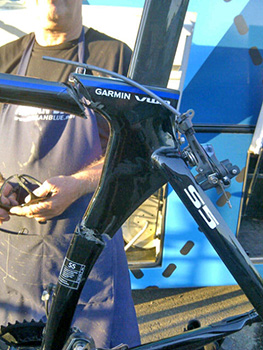
ineptitude is one of the conditioning factors that promotes learning, though more favourably phrased along the lines of 'if you don't make mistakes, you'll never learn'. more acutely this has much in common with if you don't fall off, you're not trying hard enough' but either way these are conditioned by the need for something to go (horribly) wrong in order to gain perhaps only a sliver of knowledge. of course, if you don't learn from your mistakes, all will have been in vain, but i like to think of us as an educated bunch, less prone to the blunderings of life.
in a small pond like islay, it is relatively easy to consider oneself to be a big(ish) fish, and during my early years, i was the big fish when it came to bicycle mechanics, if only because there were no others with the interest, knowledge or specialist toolkit to make broken bikes better. as with many a personal endeavour, in this area of clumsiness i am self-taught, not through any form of conceit or arrogance, but as the necessity of invention. being one, if not the only member of my adopted society to make the bicycle my sole means of transportation, the lack of a local bike shop meant that all repairs would need to be self-inflicted.
it is a feature of small communities that knowledge of local events has a grapevine all of its own, and it didn't take long for rusting heaps to be brought out of decades of retirement in order that i might prepare or repair them for the modern world. i had all but mastered the rudiments of looking after my own velocipede, but many of those resurrected bore little relation to the componentry i had become almost competent at repairing. the added frisson to all this was a complete lack of knowledge regarding the physical properties of certain (actually, all) metal variants composing bicycles of any age or condition.

thus, when an elderly roadster of indeterminate vintage arrived at my back door with a note to reconstitute some form of efficacious braking, i really paid little or no never mind, figuring it to be most likely a recalcitrant cable. as it turned out, this was an incorrect diagnosis, which any idiot could have noticed had they bothered to simply look at the front caliper. the outer leg had managed to skew itself slightly outwards, pulling the rubber away from the rim. that sort of thing will tend to reduce any form of stopping power.
unless you're a professional mechanic, don't tell me you wouldn't have done as i subsequently did, and attempt to bend the caliper arm back to the straight and narrow? those of you with that extra degree of knowledge will have seen the unfortunate result coming a mile away; the arm cracked and broke off. fortunately for me, the owner was more interested in the bike being able to stop safely, than for any need to remain true to its original era, thus replacing the caliper with something less vintage caused no anguish whatsoever. thereby is a lesson learned when it comes to understanding your fabric of choice.
at one time, and i know you don't need me to tell you this, all our bicycles were fabricated from steel tubes, either lugged together, fillet-brazed or more recently welded. the understanding of this metal is one that not only survives to this day, but one that continues to be developed by many within the bicycle industry. the phrase 'steel is real' has become something of a cliche and a t-shirt slogan, but it does have a ring of truth about it. moving from steel to aluminium in the latter part of the nineteen nineties may have had a bearing on the costs of mass producing bicycles, since aluminium can only be welded, and more importantly, welded by machines. however, as i have pointed out above, aluminium doesn't really dent very well or bend; it cracks.
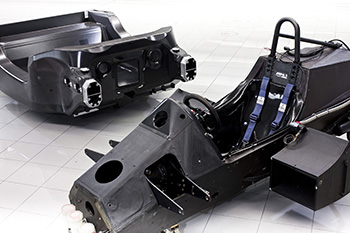
that's why aluminium frames arrive with replaceable dropouts. you can't bend an aluminium one back into shape.
though the latter material is still employed in the production of bicycles, it no longer occupies the upper reaches, a portion of the atmosphere now wholly owned by carbon fibre or, as mike burrows once described it; 'burnt plastic'. the majority of modern cycle frames are built by hand, even those emanating from the large factories in taiwan. there was recently a very pertinent article published on velonews.com pointing out that while many have a fascination with the handmade bicycle, usually relating that particular genre to the realm of steel, those moulds do not place carbon matting and accompanying resin all by themselves (at least, not yet they don't). all the matting and carbon nano fibres are placed into both halves by experienced hands, removed by hand, then trimmed by hand. to all effect, those taiwanese models could just as realistically come under the heading of handmade.
that, of course, isn't the argument under consideration. those of you who follow garmin sharp rider, david millar, on twitter, may have seen the photo he posted of robbie hunter's cervelo after a stage one crash in the tour de france. it would be tantamount to misrepresentation if i were to point out that a steel frame would not have looked like that after a similar crash, one that wasn't trivial by any manner of means. carbon fibre is several orders of magnitude more malleable than that of steel or aluminium. metal tubes can be of plain gauge, single, double or triple butted in order to maximise their potential and flexibility as a means of building a racing bicycle, capable of providing a lively and lightweight bicycle.
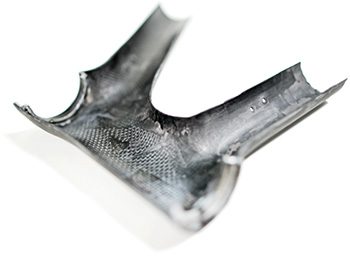
carbon, however, can not only be shaped for aesthetic, aerodynamic or dynamic reasons, but can have variations in thickness of layup, an all but infinite set of angles applied to the carbon strands and wide alteration of the resins in which the carbon sits. it's a material that has received extensive testing and development in the world of formula one motor racing where its inherent strengths have allowed many drivers to walk away from what at one time would have been fatal crashes. however, all is not pink flowers and chirping birds in the land of carbon, as the photo of robbie hunter's bicycle amply displays.
so why are we so obsessed with carbon fibre as a material with which to build racing bicycles?
lest you think i overdramatise the situation, i am well aware of the difference in level of use demonstrated by professional cyclists in comparison to the more sedate manouevres carried out by our more civilian propensities. for starters, few of us could reach the speeds of the professional peloton, nor are we as likely to be travelling at those speeds in such close proximity to dozens of others travelling at similar velocity. the chances, therefore of doing as robbie did are, by comparison, considerably minimised. we do, however, fall off every now and again; remember if you don't fall off, you're not trying hard enough.
carbon fibre is, however, very cool. few could ignore the attention garnered even by civilians when they ask to lift it in order to see just how little it weighs. carbon has that ability in spades, and if all that means little to you, the pros ride these, and cycling is one of the few sports where, bank balance allowing, it is possible to ride the very same machine as the heroes of the day. however, if i buy the same dw drumkit as billy ward, there is little to no chance that i will ever play as well as he does. similarly, if i buy a colnago c59, i will never ever wear the yellow jersey for ten days in july. but the balancing factor is that the professionals ride those carbon slivers because that's what they're paid to do. if it breaks, a new one is provided, and they're looked after with meticulous care each and every day by professional mechanics (who would never bend an aluminium caliper back into place).

now this is not a tirade on behalf of the framebuilders of the world who continue to ply their trade in brazed or welded steel tubes. i have nothing personal against carbon fibre; it is extensively used in the fuselages and wing roots of several large aircraft, including the new boeing dreamliner and the airbus a350. for the sake of argument, we will assume that the civil and federal aviation authorities are less swayed by a faultless carbon weave under a glossy clearcoat than are we. i have a colnago c40 art decor in the bikeshed which has nary a mark upon its fuselage, despite being more than a decade old, and i expect it to remain so for many a long year to come. it's a fabulous bike to ride, it looks great and has handling to match, with still the ability to impress in the hefting stakes.
however, given our civilian and more pedestrian demands on the average bicycle frame, is it maybe time that we re-assessed our present obsession with carbon fibre in relation to the bicycle frame and attendant components. be realistic; how light do you really need that bicycle to be in relation to the speed you figure you can achieve on the way to the coffee shop? to re-iterate, i would hate to see carbon disappear from the world of cycling, but i really would like to see just a tad more perspicacity when it comes to just how light that carbon fibre needs to be.
monday 2nd july 2012
 ..........................................................................................................................................................................................................
..........................................................................................................................................................................................................pau to bagneres-de-luchon

Robert Millar liked to refer to the sprinters and rouleurs as 'the animals'. His own graceful rhythm and
smooth climbing style, on the other hand, made him a higher being - quite literally. Once described as a 'Dickensian chimney sweep' due to his slight appearance, the Scot was France's best amateur in 1979 when he rode with the ACBB club. He subsequently joined the pros at Peugeot and in his first Tour, in 1983, Millar broke away on the Peyresourde, leaving Colombia's Patrocinio Jiminez in his wake to become the first Briton to wear the polka dot jersey.
A year later, in 1984, he took the overall KOM title, defeating his main adversary Luis Herrera, another Colombian. One of the best climbers the sport has seen, Millar once remarked, 'I enjoy seeing people disappear behind me.'
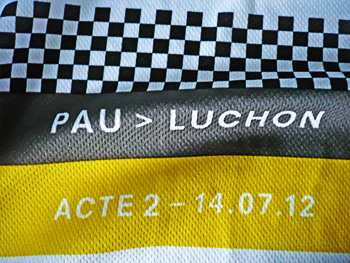
the commune of pau lives on the northern edge of the pyrenees, a range of mountains that straddles the border between france and spain. it's the capital of the french pyrenees-atlantiques departement, as well as that of the bearn region. it carries out local administrative tasks along with the thirteen neighbouring communes and the existence of the university de of pau and pays de l'adour ensures a reasonably high student population incorporated in the town's overall number of around 85,000. in the centre of the town is a substantially sized castle, the chateau de pau, famous for being the birthplace of france's 16th century king, henry iv and as having been napoleon's holiday home when in power.
bagneres-de-luchon, in tour de france terms, is 197km to the south east. more regularly referred to simply as luchon, it is around 140km southwest of toulouse, celebrated for its thermal springs, of which there are forty-eight, rising in caves that penetrate around 100 metres inside superbagneres mountain. it's also celebrated as a pretty trendy resort and home to a population of a mere 2,600 people.
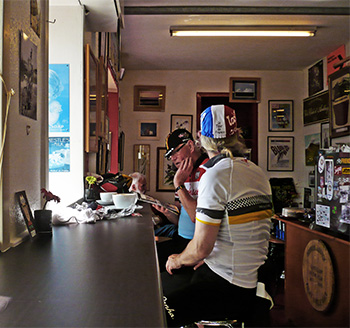
these two towns are, in cycling terms, separated by some of the most fearsome pyrenean climbs: the col d'aubisque, the col de tourmalet, the col d'aspin and the col de peyresourde, before descending to bagneres-de-luchon. it's the 16th stage in this year's race on 18th july, but it also constitutes the etape du tour acte two, a ride taking place four days previously on 14th july (acte one is on 8th july). taking into account the severity of those four massive mountains, there's every possibility that the peloton will find one or two etapists still valiantly attempting to finish, even though well outside their own time-limit.
twenty nine years ago, scotland's robert millar, taking part in his first tour de france, rode the very same route from pau to luchon (stage ten in that year's tour). riding in company with the colombian, patrocino jiminez and metauro mobil's lucien van impe, the latter was literally ridden off millar's back wheel. then, on the few remaining metres to the summit of the peyresourde, with pedro delgado closing on this leading pair, and a mere fifteen kilometres from the stage finish, millar, riding for peugeot, simply left jiminez standing with an acceleration that was not only staggering to watch, but left jiminez with nowhere to go but backwards.
sometimes, and we've all been there, you find yourself in a situation you hadn't expected to be in, one that offers a number of possibilities, not least of which is that of attacking for an unexpected victory. had robert planned on dropping jiminez on the peyresourde?
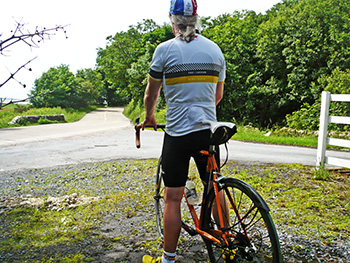
"Yes. I had Pascal Simon who attacked the group behind so I could sit on Jiminez during the valley section just before the climb. That wore out the little Colombian, as it was windy. If I hadn't dropped him on the uphill, I was pretty sure to drop him on the downhill, or beat him in the sprint."
so it wasn't one of those delightful opporchancities that landed in his lap? "No. I had a plan."
robert opened a substantial gap on jiminez in a very short space of time, before completely burying himself all the way to the finish. he even had time to sneak a peugeot cap from his back pocket and place it on his head, then zip up the chequerboard peugeot jersey, before crossing the line with both arms stretched above his head in celebration of a definitive stage victory, comfortably ahead of a chasing pedro delgado. with that, he became the first briton to wear the king of the mountains jersey in the tour de france, a feat he repeated in 1984, but this time taking it all the way to paris.
with that first victory stage win in the pyrenees, did robert find those mountains more suited to his style of climbing, or was it simply a case of them endearing themselves more to each subsequent year's strategy?
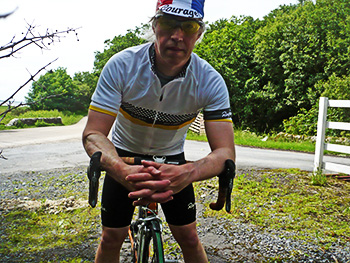
"I liked the Pyrenees more than the Alps, maybe because they usually came first in the lap of France and I was not worn out. I felt the air was slightly fresher, and though the roads were often rougher, they just seemed to suit me better.
"When I did races like the Dauphine or Tour De Suisse in the Alps, I was OK with the climbs so I think it was more a question of freshness and the natural adaptation to the first big mountains at the Tour. And that was usually the Pyrenees."
with a real chance that this year, a briton could once more stand on the podium in paris, this time on general classification, it behoves us well to remember the major steps made by previous british riders leading us to this point. until bradley wiggins reached fourth place in the 2009 tour de france, robert's fourth in 1984 was the best placing by a british/scottish rider in the history of the tour. with the tour revisiting this important, monumental stage this year, and installing it as the second of two etapes, rapha have produced the official jersey (in party with organisers, amaury sport organisation) not only looking towards the etape, but commemorating millar's historic stage win in 1983.
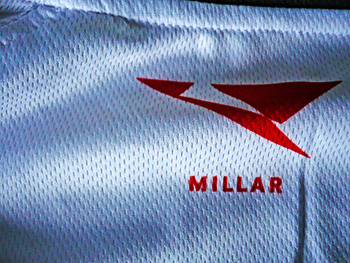
though perhaps better known for their creative use of sportwool, the rapha etape acte two jersey is crafted from good old fashioned polyester, featuring a remarkably subtle nod to the chequerboard pattern that decorated the iconic peugeot jersey of yesteryear, including the inside of the jersey's collar. just below the collar atop the back of the jersey is a red stylised graphic of an eagle accompanied by the name millar. the colour red is significant in this context.
it seems truly inadequate of me to have confined this jersy to climbing the gravelly slope up past the rspb centre at aoradh farm, having found a way to scrabble past the two riders in front of me at the time. not quite managing to deal the devastating sort of blow that robert would have been proud of, i nonetheless reached the top first, which, in truth, isn't saying much. and rather than hammer on to the cottage at saligo, i sat up and waited for the others to catch up. the jersey's heritage is far greater than my ability to do it justice, but let it not be said that the spirit wasn't willing. there is pride in the wearing.
the grey and yellow hoops offer the legend etape du tour on the front, while the back proclaims the stage start and finish towns along with the date of this second of the etapes. there are the requisite three rear pockets and, in anticipation perhaps of an exhausting day in the saddle, a full length zip. no zipped rear pocket though. the fit (medium reviewed) is immaculate. whether or not you have any intention of pulverising those four climbs come 14th july, this is a jersey opportunity that simply cannot be ignored by any self-respecting robert millar fan. i have augmented mine with a millar feature of later years...
...a ponytail.
the official cycle jersey for the etape du tour act two, produced in a collaboration between rapha and amaury sport organisation is available in sizes from xs to xxl at a cost of £50. there is a similar offering for etape act 1, celebrating the talents of thierry claveyrolat.
sunday 1st july 2012
 ..........................................................................................................................................................................................................
..........................................................................................................................................................................................................s
next please...

butchers' shops used to have sawdust on the floor, and though i've been a vegetarian for a lot more years than i'm ever going to admit, i can recall being sent out by my granny to buy the necessities for sunday lunch. this meant, in those black and white days of nostalgia, being accompanied by my younger brother and carrying a real shopping bag and granny's purse with just the right amount of money. unlike the purgatory i have just endured in bowmore's only supermarket, not everything was in the one place, packed in a polystyrene tray and wrapped in stickered polythene. try as i might, i cannot ever remember being offered a second cut of meat free with the initial purchase. bogof had not yet been invented by nasa.
though the optimism of youth had yet to embrace the tiresome ordeal that shopping has undoubtedly become, flitting from butcher's to greengrocer's to hardware store brought a variety of scenery and style of price ticket that has been smoothed into ubiquity by today's one size fits all bar-code conditioned supermarket. and now that you come to mention it, i don't recall endless loops of elevator music being played while i discover that everything on special offer is out of stock.

modernity has its moments, bringing us additional extras that aid the experience of most everything, and if not specifically responsible for any extra speed on the bike, they are cunningly constructed to at least persuade that they might be. or could be, if only we'd periodised our training schedule when we were advised so to do.
oven-ready is the new hand-crafted; no longer is it necessary to trawl several individual shops, and never was it possible to be handed an everlasting carrier bag that will undoubtedly be forgotten by the time next saturday hoves into view. the modern, operative word is convenience, catering insatiably for the culinary incompetent such as yours truly. i should, i realise, have nothing about which to complain.
however, various aspects of modernity attract criticism and vitriol, not always aimed at any specific convenience. a couple of weekends past, a fundraiser for islay's traditional music festival held in november, featured a band sitting midway between the traditional and electronica, not a complete unknown in this day and age, but on evidence of their ep on itunes, geared more towards the populist vote, rather than sincerity of expression. the possibilities laid bare of employing the computer to carry out some of the grunt work might pay dividends in the studio, but provides the stage presence of a wet sock when viewed in an islay village hall. the emperor's new clothes are being given many an airing these days.
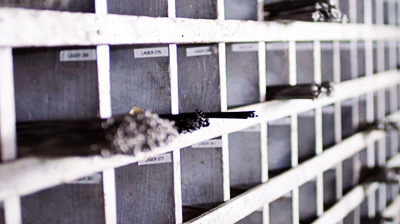
i have written at length regarding my less than justifiable procrastination when kitting out my orange and blue molteni colnago master, but in truth, unless the services of a new frame are immediately required, there is substantial pleasure to be had cogitating over which assemblage of components ought to decorate its outlying regions. modernity again, has aided the process; many an online cycle shop allows much rumination over favouring one groupset as opposed to its precedent or antecedent, flexible to within a few pounds of any notional budget that might have been targeted at the outset.
this is a particularly efficacious method of outfitting for those, like me, substantially estranged from a local bike shop. it goes without saying that traipsing in and out of bike shops (plural) occupying many a glorious minute looking at polished alloy or shiny carbon in its natural habitat, is preferable to pixellation, but occasionally unavoidable. recounting and adding up all aspects of modernity that are perhaps less than attractive, will only lead to moments of one man's ceiling is another man's floor. what i perceive as having lost all pretence of a soul, others will rejoice as offering greater choice, flexibility and economy.
you truly cannot please everybody, it's just that some of us moan about it more than others.

we all need wheels; that is something of a tautological statement. riding a bicycle is made so much simpler with the addition of a good pair of wheels, and the vast array on offer from pretty much everyone, can be seen either as a curse or a boon, depending on your budget or knowledge. however, such an embarrassment of riches has removed an important factor of completing a bicycle, one that many a present day cyclist will have never had the pleasure of undertaking, and in many cases, probably never will. visit a particular region of london village in the search for a bespoke three-piece suit, and a plethora of shops exist to service your every need, and cater to your every whim. the same can be true of a bespoke pair of wheels.
a large part of the joy is at the discussion stage, when more or less everything is possible and specific parameters have yet to be set in stone. it's also an aspect of garnering a pair of wheels that may not be quite a dying art, but certainly one that is considerably less in evidence in present times. but it is still my opinion that a custom built pair of wheels is the finest and kindest thing any cyclist can present to his/her bicycle. the ideal arrives from often lengthy discussion with the (your?) wheelbuilder, one that involves taking into account the bicycle to which they will be attached, the type of riding intended, rider weight and many another specific that can make a substantial difference over a pair of factory builts which ultimately have to be all things to all people.
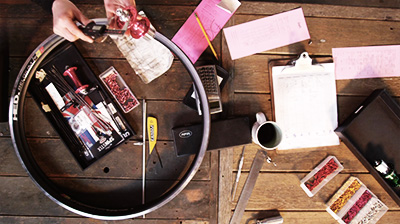
modernity has, of course, not excused itself from the specialist wheelbuilder. though it used to be simply a case of butted, stainless steel spokes allied to a set of aluminium rims, carbon is now a much proffered (and accepted) option, as is a spoke count that barely reaches double figures. however, confidence can be assured, as a personal visit at least brings builder and cyclist into visible contact, allowing ultimate judgment as to the physique of the prospective customer. (it's an easy pass to tell the bloke in the shop on the phone that your weight is lower than to which the bathroom scales attest. that's how spokes break).
i am not mitigating against the purchase of factory-built wheels, but save those for the run of the mill. when almost all your life's savings have gone on the ultimate frame, make sure there's a few pennies left for the utlimate handbuilt wheels to accompany it. make an appointment with derek at wheelsmith, jude at sugar or whomsoever you wish to entrust your velocipedinal wellbeing. reconnect with one of cycling's all but forgotten rituals and then ask your butcher why there's no sawdust on the floor anymore.
saturday 30th june 2012
 ..........................................................................................................................................................................................................
..........................................................................................................................................................................................................genius

the word genius is one that is regularly and almost casually bandied about these days, frequently in situations inappropriate to its true meaning, and i hold my hand up, guilty as charged for being one of the principal offenders. connotations range from the pointing out of something so obvious that it wasn't thus until pointed out, all the way to theories of relativity, of strings and of bosons that carry the forename higgs. though the latter is a particle predicted by peter higgs and thought to be one of the missing pieces in the fabric of time, space and the meaning of life (which we already know to be 42), to my way of thinking, the true marvel and devourer of scientific budgets, is the large hadron collider, hidden in the depths of the swiss countryside (and i do really mean depths) 100 metres below the swiss/french border at geneva, lest it inadvertantly cause a black hole on the motorway.
disappearing motor cars in substantial quantities never looks good on the corporate press release.
it's one thing to use calculator, slide rule and the fingers of both hands to predict the existence of just such a particle - and indeed all manner of quarks and gluons - quite another to devise a way of finding them. as often seems to be the case, the machinery required to point out the existence of a particle unseen by the naked eye and apparently devoid of any mass to speak of, often reaches gargantuan proportions; such as the large hadron collider.

it is, by definition, surely incumbent on the designers of just such a device, to have a not less than complete understanding of just what it is/was that peter higgs was describing. it would be tantamount to foolhardiness to go looking for a needle in a haystack were one not appraised of just what a needle looked like in the first place. were monty python still to fill the airwaves, it is easy to visualise the sketch where several white coated boffins stare blankly at a computer screen while one exclaims "is it a higgs boson? darned if i know.". though i'd be less than surprised if one or two moments as such hadn't already taken place at cern in geneva.
ultimately, the existence or non-existence of this particle is of academic interest only. such sightings, even if for mere milliseconds, may indeed assist scientists in comprehending the world, nay, universe in which we hurtle headlong into the abyss, but for the majority of us, black holes around geneva notwithstanding, it makes little no never mind. were this evening's news headlines to announce that the particle did/did not exist, most of us would still get up in the morning, have breakfast and go for a bike ride, unconcerned (see what i did there?) that chainreaction might no longer have higgs bosons in stock.

thankfully, the apellation genius can be applied in more than one way, several of them of far more interest to our day to day living. far from being unapproachable boffins in white coats, continually rehearsing their nobel prize-winning speeches, some of them are the very embodiment of the guy next door with a vice on his kitchen table. in fact, that's exactly the scenario for whoever lives next door to graeme obree in saltcoats, ayrshire.
mrs washingmachinepost is currently in scotland, so i have been an orphan for this past week. i have not, she will be pleased to hear, been whiling away the hours in lax fashion, but perennially at the other end of a paintbrush, pretending to be a painter and decorator (with the emphasis on pretending). i know that the unruly state in which i have left the room being decorated would win me no brownie points, but i have assured myself that all will be tickety boo by the time she disembarks the calmac ferry tomorrow eve. it is this same sense of dread that has prevented my attempting to repair or upgrade any of my bicycles on the kitchen table, though i have been known to replace an errant computer fan in my previous macintosh laptop on this very surface. the concept of bolting a large vice to the edge of said dining table is one that should not even be considered in mrs twmp's presence.

graeme obree, however, lives alone and is not party to the female sense of orderliness that pervades the average modern household. and with a pressing need to create a human powered vehicle on which to break the land speed record this coming september, he has free rein to intersperse his cornflakes with that of welded tubes and diverse bits of transmission. many of you will already have seen the agglomoration of welded tubes and bits of saucepan that comprise graeme's vehicle for the record attempt, and i don't doubt that one or two of you will have been trying to figure out just how he intended to pedal the bicycle when nevada hoves into view in just over two months' time. i have shared your concerns.
however, thanks to a video now on graeme's website, all has been revealed, and even though it took a moment or two to work out the niceties of his design, mostly because the bike is upside down on the kitchen table, i think it not entirely unwarranted to bestow the term genius upon the man spinning the cranks.

many record attempts in modern times are consumed with the consumption of finance, and a vehicle such as this in the hands of any other would likely have been sub-contracted to the such as the formula one guys at factor 001, who would have built their own version of the large hadron collider in an effort to replicate the exact features as dictated by their fluid dynamics software and spent several expensive hours in a wind tunnel in california. graeme does not have the finances for such luxuries, but in truth likely has no need of such excess. the frame has been cut, mitred and welded by hand (probably in his kitchen), a saucepan he deigned surplus to requirements has been hacksawed into use as shoulder rests, and the short, stumpy bar ends have been clothed in tartan. last but not least is the transmission ably demonstrated in the video below.
genius.
all that remains is the construction and fitting of an appropriately formed fairing to cheat the wind resistance that travelling above 80 miles an hour will undoubtedly induce. few of us doubt that he'll break the record, but even if that fails to be the case, the journey up to that point will have yet again celebrated the single-minded approach that marks graeme out as one of cycling's most valuable players. if he didn't exist, we'd have to invent him.
friday 29th june 2012
 ..........................................................................................................................................................................................................
..........................................................................................................................................................................................................cycling in the hebrides. a cicerone guide by richard barrett. cicerone publishing. 300pp illus. £14.95

in the few years subsequent to my moving to islay, the dawning that it was all but impossible to purchase anyhting like a decent bicycle for reasonable money brought me to stock one or two at a time and lay myself at the mercy of islay's bicycle buying public. christmas was always a good time, predominantly for smallish bikes for the little people of the isle, though on occasion someone would take fitness as their principal priority and buy a wholly inappropriate cycle (the customer is always wrong) to leave lying in the shed or porch until they could no longer remember why they'd bought it in the first place.
though i would hesitate to pronouce myself an organised sort of chap (and there are many who would broker no argument with that statement), on the run-up to christmas i endeavour to make sure that i have the necessary presents for the correct people already (badly) wrapped and hidden under the bed. yet on one of those early years, on a very wet christmas eve around 9:30pm in the evening, i heard a knock at the back door, opening to find a couple wondering if i might just conceivably have a bicycle that would fit their child as a christmas present, due to the order from the catalogue having failed to arrive in timeous fashion. by a strange and never repeated quirk of fate, not only did i have a bicycle in stock that fitted, but it was even the correct colour.
all has changed now, and the carriage rate to the isles increased to the point where it no longer became economic to stock bicycles in small quantities, particularly when compared to the two for fifty quid offers that occupied a full page advert in the weekend colour supplements. however, around a year before this state of affairs spelt doom for my cottage industry, i was purchasing my stock from a fairly well-known manufacturer in middle england, from whom i one day received a telephone call. they were in the process of re-structuring their sales team and wondered if i could tell them whether i was nearer to orkney or shetland. those with a rudimentary grasp of scottish geography will realise the ineptitude of such a question, but the result of my carefully worded and more than tactful answer brought the knowledge that, for the three previous years, i had been served by their east coast sales department.
that was good for a chuckle.
the topographical make up of scotland dictates that the splinters known as the hebrides are sprayed up and down the country's west coast, commencing with islay as the most southerly of the inner hebrides and stretching as far north as lewis which, rather obviously, is the most northerly of the outer hebrides. if you really must know where one set stops and the other starts, i might point you in the direction of skye, a far bigger isle than islay and with its very own bridge. everywhere else relies on the services of caledonian macbrayne ferries to get to and from the mainland, though in common with one or two others in both the inner and outer hebrides, you can get here by plane from glasgow. the latter, however, is less pragmatic for the touring cyclist, so calmac it is.
i am surprised to find that there has not been a comprehensive guide to riding in the hebrides, such as this one from richard barret, prior to now. the introduction of both a quality youth hostel and campsite in port charlotte has led to a substantial number of cyclists starting or finishing their glorious trek across scotland's isles. for this reason alone, cicerone are to be soundly congratulated on this recent publication. it may also be something of a surprise to learn that the furthest any of thewashingmachinepost bicycles have reached on this atom of delight is to that of colonsay, an isle only a few miles north of islay on the way to oban and perhaps onto mull and iona. i tell you this not in order that you might snigger at me behind my back, but to qualify my reviewing of said volume. i can, in truth, only vouchsafe for the islay, jura and colonsay pages. i have visited mull, but it shames me to mention that it was not by means of a bicycle.
cicerone guides, many of which have been previously reviewed on the post, are likely amongst the most comrehensive of the species. before making it even as far as the first part of this guide (which incorporates both arran and bits of the clyde in order to maximise calmac island-hopping proclivities), there are copious notes regarding the weather, the terrain, what to wear and how to prepare your bicycle. for some this will be casually overlooked, but purely on the strength of the repairs i have had to carry out, if you're not used to this sort of thing, i would read thoroughly and make mental note of your perceived failings.
while getting from island to island is more than adequately covered, particularly when the destination is not the be all and end all, each island is intelligently appraised for its cycling opportunities, where possible in circular fashion should you wish to leave luggage at a practical point, then to cycle unfettered. i once owned a copy of a jazz magazine that intimated just inside the cover to wit: please note that all errors contained within are deliberate and on purpose. some people are always looking for mistakes and we aim to please. unfortunately, the fact that some people (me?) are always looking for mistakes is an undeniable truism, so it gives me little true pleasure to point out one in the islay section that will reduce mr barrett's chances of gaining a free dram from one of the isle's principal distilleries. though correctly spelt on the included ordnance survey map illustration as laphroaig, the author has erroneously listed it more than once in the text as laphraoig. a simple transposition, but easily checked not only from the label, but from the map just below the mis-spelling.
pedantry at its best.
such a criticism is, however, merely superficial, making not one iota of difference to this logical and well-crafted approach to cycling the hebrides from south to north. even its diminutive size works well in its favour, making it easy to fit in a jersey rear pocket or under the clear plastic cover featured on most bar bags. i has a substantial number of pages devoted to distances, times, tourist offices and further reading at the back, helping to place the whole tome in more detailed context. if you plan to undertake all, or even a small portion of this rite of passage, i'd strongly advise purchasing this book. though we all ostensibly speak the same language out here in the atlantic, each isle has its own little foibles and varying exposure to the elements. the wrong time to find that out is on a sunday morning when everywhere is closed and the ferry has already sailed.
thursday 28th june 2012
 ..........................................................................................................................................................................................................
..........................................................................................................................................................................................................we're all doomed
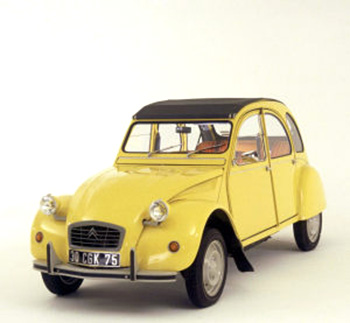
around two dozen years ago, i owned a citroen 2cv, probably the nearest that motoring has ever come to that of cycling. the car could have been easily dismantled totally with a screwdriver and an adjustable spanner. need to put an entire drum kit in the back? simples. release two levers under the rear seat and the whole kit and caboodle could be slid out through either of the rear doors. fancy a picnic in a deserted field? again, simples. take out either or both the front seats and sit them on the ground. ventilation was by means of an adjustable flap under the front windscreen, because it was an air-cooled engine, heating in the cockpit was almost instantaneous, and should either of the front windows need opening for air or, perchance, a multi-storey car park ticket, simply flap up the lower portion and it would lock into place on the outer top half of the door.
and if all else failed, you could even start the darned thing with a starting handle slotted into the radiator grille. granted, top speed was around 70mph, and acceleration measured on a calendar, but even that was a smidgeon too great for one who never truly drove over the speed of 40mph.
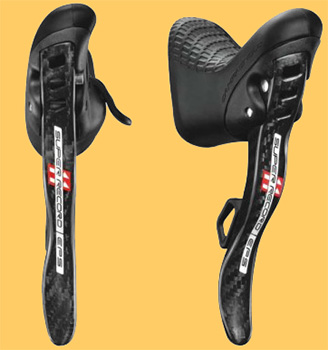
that vehicle is now long gone, and probably occupies an ecologically sound portion of landfill somewhere in northern scotland. at least, that seems likely given the direction in which it was sold. i have had one or two other motor vehicles since those halcyon days, but it is now four or five years since i last owned a motor car at all. it, i have to admit, was of more contemporary design, considerably less ostentatious than a bright yellow 2cv and equipped with many of what today's motorist would consider essentials. there is no doubt that our comfort and laziness have been more than adequately catered for with power steering, power windows, refrigerated glove compartments (?), cruise control and fingertip radio and heating adjustment from the steering wheel.
all of the above are perceived as a boon to society except on the occasions when they simply stop working, or provide intermittent respite. the nearside rear window on my volkswagen vento (now also landfill, i shouldn't wonder) suddenly decided to open itself while driving at the requisite 40mph along the low road, enough of a surprise in itself, but compounded by the fact that we were experiencing a hail storm at the time. a new window motor was priced at around £100, plus the cost of fitting, but for no charge at all, the garage offered to disconnect it, leaving the window shut. guess which choice i opted for?
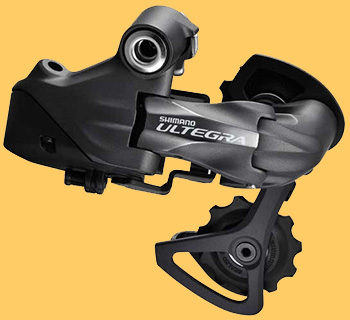
the recent (and in some cases, still current) computer problem suffered by customers of the royal bank of scotland and others in the same group has underlined to many, just how fragile our society has become with so much dependence on computers and technology in general. all posturing, however, is akin to those who wish to have the world's nuclear arsenal disappear overnight; a laudable lobby if ever there was one, but it is a truism that you cannot uninvent something once it has seen the light of day.
my initial interest in the bicycle as a means of both transport and leisure was greatly encouraged by its simplicity and accessibility. learning how to carry out simple adjustments and repairs is not a particularly onerous task for anyone, and with the possible exception of the innards of index-shifting gear levers, simplicity of operation still pretty much survives.
or at least, it did.
electric gearshifting has been around for a number of years now, and it seems that the reliability of ordinary cycling has been maintained so far. i am still very much of the opinion that the systems proffered by shimano and campagnolo are solutions looking for a problem, for i have never found it a serious burden to flip a lever connected to a piece of wire in order to maintain or alter my pedalling cadence. pressing a button seems a tad unnecessary.
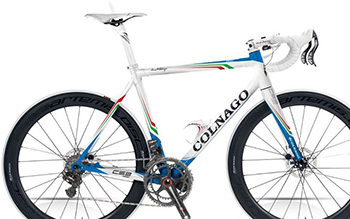
and to return to one of my perennial moans, though the offroad community has been luxuriating in the bath of hydraulic disc brakes for many a long year, is it indeed a wise move to combine that with the electrics described above on those slivers of carbon fibre with which we are currently obsessed? it is no secret that the governments of the western world are keen to point out the obesity crisis that threatens our present and future, and though it would be naive to consider the modern day roadie to be exempt from this, overall it's just as likely as meeting a fat vegetarian. couple this with the rapidly descending weights of those carbon slivers and the (electronic?) componentry with which they are garnished, and i find it hard to balance the equation of requiring an increase in braking power on a moving object that suffers from decreased mass.
irrespective of the research and development that is attached to such as electrics and hydraulics, increasing the complexity of any situation, tautologically increases the things that can perceivably go wrong, or fail altogether. cycle racing is already one of the world's more exciting sports (apart from the first 180km of a tour de france sprint stage), one that will gain not one iota from the imposition of electric gearchanges and hydraulic braking. i have yet to hear either of the schleckwards, bertie, cav or brad mention in their post race interviews "ithe electronic shifting gave me that extra edge over the (similarly equipped) peloton, but if only i'd had some hydraulic disc brakes, i'd have owned that green/polka dot/yellow jersey" (delete as applicable). so far all the advances seem to be emanating from the manufacturers and not from any of the riders. ever tried retrofitting hydraulic discs to your steel colnago master? maybe you need to buy a new frame then.
mark my words, the end is nigh.
wednesday 27th june 2012
 ..........................................................................................................................................................................................................
..........................................................................................................................................................................................................the dirtiest race in history. richard moore. wisden sports writing. hardback 326pp £18.99

it's comforting to inhabit a niche, even if, or perhaps especially because, the inhabited niche is a small corner of a larger, yet still petite niche. in the grand scheme of things, cycling is a very small part. some would wish it to become a much larger, though still miniscule part, while others secretly or openly delight in the fact that they have pledged allegiance to just such a niche and would prefer that it remained that way. for the ego is munificently pandered to if thought of as special.
thus it is with cycling. though in no way representative of the grand whole of which we are all a part, accept that around 5,000 persons walked through the entrance to the very first scottish bike show in the secc in 2011. if we take scotland's population as hovering around five million, that's quite a small percentage who took it upon themselves to go look at some bicycles. position that as a percentage of the population of great britain and my grasp of fractions leaves me floundering in front of the calculator.
we do, however, share common interests with others and concomitantly, common problems. these may be perceived as pertaining to traffic matters, those of a social nature, but particularly when narrowed to the realms of sport, drug related matters. despite the daily newspapers declaring open season on cycling whenever the date nears that of the tour de france prologue, contrary to common apprehension, other sports suffer from drug cheats too.
this is not an area in which i find great comfort, and i will readily admit to a head in the sand policy when that which obeys the law of omerta raises its ugly head. this does not, though i may have been accused of such, sustain due to any sympathy with or for, those who take or have taken performance enhancing drugs. i have no perfromance to speak of in the first place and thus no need to indulge. nor do i require to carve out a living in any form of competitive sport, so the need has never surfaced in personal life. the crux of my evading the subject is a lack of any real informed expertise; basically, i know not of which i might write.
while this has not prevented scores of individuals casting their opinions upon the great unwashed through blogdom or twitter, i cannot justify doing likewise. even the niche of cycling in which i find myself, features too complex a series of reasons and justifications, however weak, for drug use in the sporting melee. but, as we may well be aware, this is not purely endemic to the world of cycling.
author richard moore first brought himself to our attention via his excellent opening narrative concerning the search for robert millar, a volume which subsequently did not find him favour with the great climber, but for reasons not allied to his superb writing. he has gone on from strength to strength (sorry, a really poor cliche) via books such as slaying the badger, heroes, villains and velodromes and sky's the limit, and to my mind has proved himself one of the finest writers of modern times. to date, all the above have concerned aspects of the little niche world i described in my opening paragraph, yet here he is, stepping out of one niche and right, slap, bang into another; the world of athletics, in particular, the 100 metre sprint.
but in this case, it's not just the 100 metre sprint in general, but the dirtiest race in history as ascribed in the book's title, between america's carl lewis and canada's ben johnson. as races go, the 100 metre sprint occupies considerably less time than any cycling event. currently the record belongs to usain bolt at 9.58 seconds, but the race to which moore's narrative eventually travels, took several fractions of a second longer. 9.79 seconds to be precise. (or not, as the reader will eventually discover). and perhaps at this point it is right and proper to consider just how a period of less than ten seconds can be turned into a hardback book of considerably more than 300 pages. there's only one token illustration for heaven's sake.
in the light of the previous, it's where the men are separated from the boys, or perhaps more aptly, where the readers are separated from those who are authors, for this truly is a work of masterful construct, research and narrative. i am firmly of the opinion that, when attending a stage play or presentation, if the eye starts drifting towards the scenery and how well or badly formed it might be, either the playright or actors are failing in their duty. similarly a work of this magnitude; the reader should be carried headlong into the chronicle, blissfully unaware of the countless air miles racked up in the process of forming each chapter. this is a book that fulfils that to the very last word. however, in the process of reviewing same, it would be most ungracious, not to say remiss of me, to point out that richard moore has elevated the art to a whole 'nuther level.
for in truth, i could care less about how fast anyone can manage to put one foot in front of the other over a distance of 100 metres, yet it would not be overstating the case to admit i was totally captivated from moore's opening paragraph until reaching the substantial index at the back. in order to attain a purpose in life, an author ought to be able to hold the attention well beyond any alotted time allocated for reading. i read chapter after chapter until the bathwater went cold, then i sneaked in a few more pages while i waited for the tea to cook. and i'm not sure that i exaggerate when i portend that i may be the only person on the planet that richard did not interview about those 9.79 seconds.
you will be unsurprised to learn, particularly after my convoluted opening words, that the stars of the story are not necessarily those of lewis and johnson, but those of performance enhancing drugs, those who used them, and those who promoted their use. lewis comes out of the story, if not smelling of roses, then certainly smelling a lot less of manure than his canadian opponent (even if the jamaican, johnson, was only an adopted canadian). neither do the figures in power at the international olympics committee or the international athletics federation leave the building in clean white suits. and though the late nineties and early noughties have hardly seen cycling's greatest contribution to a carefree sporting society, some ten to fifteen years earlier, so-called amateur athletics was gaining a head start.
it would surely have been easier for moore to have simply recounted the racing, the athletics and the drama without examining the culture behind the events that brought drug use to the almost inextricable level that it appears to have achieved. that would doubtless have made for an exciting enough drama in itself, if unavoidably leaving the story in pure black and white. it is, however, the grey areas in between, that makes the dirtiest race in history the undoubted triumph that it is. there is ultimate joy for the reader in following the unravelling of a whole string of apparently intertwined conspiracies; if you are unaware of how that 100 metre final in the seoul olympics of 1988 panned out, or if the result would be one of your aces in a local pub quiz, you owe it to yourself to read what is probably the finest sports book published this year.
to find a comparative work of excellence, you may have to revisit matt rendell's 2006 opus the death of marco pantani to find anything as brilliant as this. who cares if we're cyclists and lewis and johnson aren't? compulsive and compulsory reading.
tuesday 26th june 2012
 ..........................................................................................................................................................................................................
..........................................................................................................................................................................................................